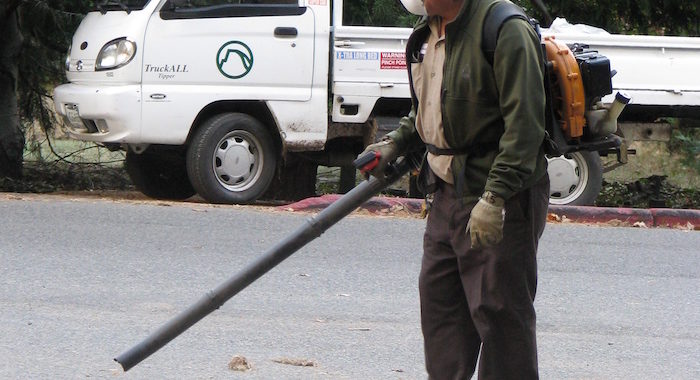LEAF BLOWERS Gardening tool used to remove leaves and light debris from gardens, lawns, roofs, and roads Used for housekeeping on the construction site Can be hand-held, carried as a backpack, or pushed (with wheels) Hand-held Backpack Pushed Leaf blowers typically have 2 to 4 stroke engines and a nozzle that propels air out to blow leaves Some leaf blowers have electric motors with cords Some leaf blowers are designed to suck leaves into a bag which is attached According to OSHA 1926, 302, a leaf blower is categorized under Power Driven Tool 1 1. OSHA 29 CFR 1926 Construction Industry Regulations. Geneseo, IL: Reglas Press, LLC, 2007. Electric Suction Type A 2-stroke leaf blower engine produces 90-100 dB of sound nearby and 70-75 dB at a distance of 50 feet from the engine 2 Can cause hearing problems for the operator using the leaf blower Can cause hearing problems to nearby residents if the leaf blower is frequently used in the same area 2. http://www.nonoise.org/quietnet/cqs/leafblow.htm Emits (gas-powered) carbon monoxide and hydrocarbons 2 Produces particulates in air 2 Produces (gas-powered) as much smog as 17 cars 2 Smog causes asthma, bronchitis and other lung diseases, reducing the ability to fight against infections 3. http://www.nonoise.org/quietnet/cqs/leafblow.htm There were two leaf blower-related fatalities reported to OSHA from 1990 thru 2009 5. OSHA Construction Worker Fatality Data (1990-2007). A worker was using a leaf blower on the roof of an apartment building 20 feet above the ground. He slipped and fell onto the sidewalk below. He was transported to the hospital but died from massive head and body trauma. 5 Proposed Safety Measures: As per OSHA 1926(501), employees working at a height of more than 6 feet above a lower level should be protected from falling using guard rails, safety nets or personal fall arrest systems. 5. OSHA Construction Worker Fatality Data (1990-2007). A worker was on a tailgate and was pulling a 8 horsepower leaf blower along. He was jarred from the truck and hit his head on the ground, suffered a severe head injury, and later died at an area hospital. 6 5. OSHA Accident Investigation Data (1990-2007). OSHA 1926, Subpart E, PPE 4 requires : Gloves for protection in case of fuel spill or fire and contact with hot engine. Goggles for eye protection from dust and smoke Ear plugs or head phones for protection against noise 4. OSHA 29 CFR 1926 Construction Industry Regulations. Geneseo, IL: Reglas Press, LLC, 2007. Breathing protection from dust and smoke Body protection in case of fuel spill or fire Carefully read and follow instruction manual Check the fuel (check for leaks) before use Keep appropriate oil level as indicated in manufacturer’s label Start blower away from fuel container During refueling, turn the leaf blower off and do not smoke OSHA1926.302(c)(1) – All fuel powered tools shall be stopped while being refueled, serviced, or maintained, and fuel shall be transported, handled, and stored in accordance with Subpart F of this part. 6 Use personal protective equipment such as gloves, goggles, ear plugs, and masks or any other type of breathing protection Make nearby workers aware that the leaf blower will be used Do not blow toxic substances or chemicals Do not direct the leaf blower toward other people Provide ventilation if the leaf blower is being used in interior space and check for the concentration of toxic gases OSHA 1926.302(c)(2) – When fuel-powered tools are used in enclosed spaces, the applicable requirements for concentrations of toxic gases and use of personal protective equipment, as outlined in Subparts D and E of this part, shall apply. 7 Use fall protection system when using on roof or any surface above 6 feet from the lower level 7. OSHA 29 CFR 1926 Construction Industry Regulations. Geneseo, IL: Reglas Press, LLC, 2007. Use a fall protection system when using the leaf blower on a roof or any surface above 6 feet from the lower level OSHA1926.501(b)(1) – If an employee is on a walking /working on surface or edge that is 6 feet or more above a lower level, shall be protected from falling by guard rail, safety net or personal fall arrest system. 8 OSHA1926.501(b)(2) (i)– If an employee working at a leading edge that is 6 feet or more above a lower level, shall be protected from falling by guard rail, safety net or personal fall arrest system. 8 8. OSHA 29 CFR 1926 Construction Industry Regulations. Geneseo, IL: Reglas Press, LLC, 2007.
